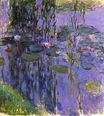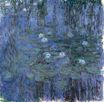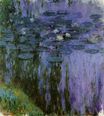Клод Моне - Водяные лилии 1919
 |
 |
 |
 |
 |
 |
 |

Водяные лилии 1919
200x200см холст/масло
Musée d'Orsay, Paris, France
The image is only being used for informational and educational purposes
<< Previous G a l l e r y Next >>
From the Musée d'Orsay, Paris, France:
"Nymphaea" is the botanical name for a water lily. Monet grew white water lilies in the water garden he had installed in his property at Giverny in 1893. From the 1910s until he died in 1926, the garden and its pond in particular, became the artist's sole source of inspiration. He said: "I have come back to things that are impossible to do: water with weeds waving in the depths. Apart from painting and gardening, I am good for nothing. My greatest masterpiece is my garden."
Eliminating the horizon and the sky, Monet focused on a small area of the pond, seen as a piece of nature, almost a close-up. No details stand out and the overall impression is one of a shapeless surface. The square format reinforces the neutrality of the composition. The lack of a frame of reference gives the fragment an infinite, limitless feeling.
Never was the artist's brushstroke so free, so detached from the description of forms. A close-up view of the canvas gives a feeling of total abstraction, because the brushstrokes are stronger than the identification of the plants or their reflections. The viewer has to make a constant visual and mental effort to piece together the landscape suggested in the painting. The unfinished borders accentuate this insistence on painting as a surface covered with paint, which was not lost on artists after the Second World War, particularly American painters exploring "abstract landscapes" and "lyrical abstraction."